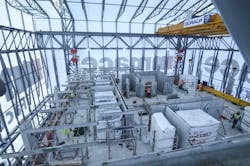Mace Group builds working on top of under-construction skyscrapers
Mace Group is London’s largest contractor, and has been associated with some of that city’s signature projects, including its 95-story skyscraper The Shard; the 443-foot-high cantilevered observation wheel known as London Eye; and Heathrow Terminal 5, which at nearly four million sf on 640 acres is the largest freestanding structure in the United Kingdom.
Since its inception in 1990, Mace has explored where production and construction might intersect. That inquest is suddenly urgent today, as U.K. cities will need 10,500 new homes to be built per month every year through 2038. To meet that demand, the country’s construction industry must rev up its productivity by 30%.
Recently, Mace took a step toward shifting from construction to production when it literally built factories on top of two under-construction residential towers in Stratford. Workers within those factories poured concrete, and assembled and installed prefab MEP systems, bathroom pods, risers, and façade components. The firm showcased its factory during a presentation at Autodesk University in London in June.
Skyscrapers rise with six-story prefab factories
The six-story factories each weighed 510 tons and were 35 meters wide, 41 meters long, and 33 meters high. Some of their spaces were dedicated to materials delivery, façade installation, and assembling sub-assemblies. The structural engineer Davies Maguire helped Mace figure out how the building would manage that weight load.
Matt Gough, Mace’s Director of Innovation and Work Winning, tells BD+C that the factories were “cost neutral” in that they eliminated the need for tower cranes, and increased productivity to the point where crews could complete 18 floors in 18 weeks. The factories reduced the project’s transportation by 40%, and its waste by 75% compared to a more conventional construction site. This project’s “gross value added” per worker, at £80 ($101.41) per hour worked, was higher than the U.K.’s average for construction and manufacturing.
“We changed the process for delivering high rises,” says Gough, even as it struggled at first to get some trades to work “in a different way.”
In January, Mace handed over the two residential towers to their developer, a joint venture between Qatari Diar and Delancey. Stratford is Mace’s sole project with onsite factories. The contractor is open to doing more projects like it in the U.K. and elsewhere (it has a construction management office in New York). Mace’s goal is to be “manufacturing” 85% of its projects 50% faster by 2022 via just-in-time logistics and sharper site management abetted by technology.
The contractor is doing modular construction on some projects, and intends to rely more on offsite prefabrication, which could result in safer jobsites with fewer workers needed.


